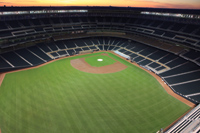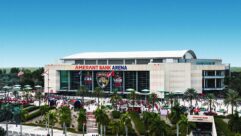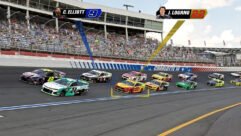

Inside the Target Field Install
Apr 12, 2010 2:32 PM,
By Dan Daley
Communication saves the build at Target Field.
Architect Populous (formerly HOK Sport) designed the open-air Target Field, opening in downtown Minneapolis this month, with a modern look, breaking with the leading architectural trend of the last decade that saw much of major-league baseball’s infrastructure rebuilt as retro-classic homage to the sports’ past. Including infrastructure and financing costs, Target Field’s price tag is estimated at $522 million.
When the Minnesota Twins got a home of their own it was full of overlapping modern systems and the integration challenges that go with them. Plus weather.
Related Links

The Buzz: Installation Spotlight: Crisler Arena, Ann Arbor, Mich.
Time had come for a change—the 40-plus-year-old PA system at the Crisler Arena…

This April, as a unique event in baseball history, a city’s two franchises both took up residence in new stadiums in the same season…

Hatboro-Horsham High School, Philadelphia
Hatboro-Horsham High School in the Philadelphia suburbs is now using a Technomad Turnkey PA system to enhance audio quality and coverage for sporting events in its outdoor campus stadium….
Architect Populous (formerly HOK Sport) designed the open-air Target Field, opening in downtown Minneapolis this month, with a modern look, breaking with the leading architectural trend of the last decade that saw much of major-league baseball’s infrastructure rebuilt as retro-classic homage to the sports’ past (witness the Mets’ new Citi Field and the Orioles’ Camden Yards). Including infrastructure and financing costs, Target Field’s price tag is estimated at $522 million.
But not only is Target Field a modern vision of a sports stadium, it is a modern example of how systems integration has changed from discreet integrated systems to what is often called an “ecosystem”—where digital systems for AV, life safety, broadcast and Internet distribution, signage, and more share physical space, bandwidth, and points of intersection. Systems must talk to each other—and integrators must do the same.
“The challenge here was coordination among all the systems vendors,” says Jeffrey Volk, director of the sports and entertainment group at Alpha Video, which worked on the video control room at the stadium. “There were a half-dozen or so contractors whose work was focused on the control room to one degree or another, from the displays contractor to wiring and systems integration. Making sure everything would connect properly with everything else was critical.”
Volk says one of the key ways of accomplishing that, in addition to regular meetings among project managers and Alpha Video’s own proprietary software solutions that tie into Microsoft Project and Excel, was to learn the process policies of other contractors. “For instance, we had to take the output of our systems and interface that with the Daktronics display installers’ processing equipment, and for that we had to rely on Parsons [Electric, the audio and cabling systems integrator] to get their signals to the control room and then from there to our interconnections, and integrate it all with the IPTV system,” Volk explains. “Having a strong project manager to spearhead and establish kind of communication is very important, especially for projects of this scale.”
Volk says project scale is a game-changer: Target Field used an estimated 50 tons of copper wire and 75 miles of fiber cable. He’s seen more integration companies attracted to the sports venue sector thanks to its robustness, especially as compared to other commercial construction. But, he says, sports venues have a significant learning curve. “We started our sports group 10 years ago, and I feel we’re just hitting our stride in terms of familiarity with the processes,” he says, the sports metaphor inserted without irony. “We have our own internal processes—our engineering phase, shop drawings, pre-integration in the shop, and then building it onsite, then testing and doing training. When you realize that a half-dozen other contractors working in the same space as you have their own internal processes, you see that it can get complicated to mesh all of those processes.”
At about 1 million square feet, the Twins’ new stadium is smaller than the average size of new generation stadiums. Volk says that that didn’t necessarily impinge on the size of critical spaces inside the stadium, such as the broadcast control room, but it did compel those spaces to twist and turn a bit to fit. That was illustrated when the layout, which includes a main video control room, two AV edit suites, and a machine/equipment room, came up against the stadium’s structural support system. The space, intended to support a staff of more than 25 people on game days, has plenty of technology packed into it, including a Ross Video Vision 3 production switcher, Evertz HD and AES routing switchers with integrated multi-image viewers, a 6-channel EVS slow-motion system, a Ross Video SMS video server, Sony HDCAMs and Panasonic DVCPRO HD VTRs, Apple Final Cut Pro-based editing systems, Chyron HyperX 3 character generators, and a Riedel intercom and communication system. Input sources include multiple Sony HDC-1400 and PDW-700 cameras and Nucomm wireless HD camera systems. But those electronics had to jockey for position with a lot of concrete. Two days of plan review conducted jointly by the architect, contractor, and the integrators resulted in Alpha Video requesting rack-maker Middle Atlantic to construct racks that were of standard width but in some cases as shallow in depth as 10in. to allow them to fit around the 4-square-foot concrete support column. Alpha Video’s cabling and racking design came up against similar jigsaw-puzzle solving when the tank for the Du-Pont FM2000 fire suppression system that was supposed to be located in the machine room was moved to one of the edit suites.
“A lot of technology has to live in there,” Volk says. “The key to making that work was having our project manager realize that this conflict was coming up and getting lines of communication opened. How often does a systems integrator think they have to talk to the fire system people?”
Inside the Target Field Install
Apr 12, 2010 2:32 PM,
By Dan Daley
Communication saves the build at Target Field.

At about a 1 million square feet, the Twins’ new stadium is smaller than the average size of newer stadiums. For that reason, crews had to work together as different equipment had to occupy the same space, such as the fire-suppression system in one of the edit bays.
The Learning Curve
For Parsons Electric—which was hired by Mortenson Construction as an integrator of voice/data, audio/video, broadcast, security, and other systems—there was more at stake than just meeting deadlines by coordinating with other vendors. “Part of out mission here was to become a player in the large-scale sports venue sector,” says Michael Couture, Parsons’ project manager on the job, who noted that Parsons acquired a local security company to buttress those skillsets and partnered with TSI Global for audio/video cabling and to help implement WJHW’s PA system design. “We literally geared up for this job,” he says, “researching other stadium projects to determine what skills we needed to beef up and augment. Anyone can run cable; it was our knowledge of the various system requirements that we were improving.”
Parsons brought on other partners, including Siemens to help develop the security systems and Infinity Scaffold to help them rig the hoists to lift loudspeakers into place. But as an electrical contractor, Parsons was certainly familiar with interaction between trades, and that took place to a large extent as they coordinated cable pathways with Gephart Electrical’s installation crews. “The most important thing for any cabling contractor to be able to meet its deadline is to have that pathway ready for you,” he says. “Mortenson and Gephart did a great job of that to help us achieve our timeline and our budget.”

For the 3’x4’ custom loudspeaker boxes loaded with JBL Control series loudspeakers, TSI Global fabricated custom brackets that would allow the boxes to be attached to the steel and withstand a 2lb. load per square inch of ice and snow as per state code.
Thin-Skinned Sound
Target Field’s aesthetic design dictated the location of many AV elements, perhaps most notably the distributed audio system. A design that called for a retractable roof was scuttled since it would have added another $100 million to the stadium’s price tag. Instead, a huge metal canopy extends out over the upper deck seating, offering fans some protection from the elements. For both aesthetic and practical purposes, it was determined that the canopy also hold loudspeakers between its upper and lower metal skins to cover the upper reaches of the stadium. However, while toward the center the canopy’s interior was as high as 20ft., with its own internal catwalk, its airplane wing-like shape—tapered severely at each end—made integrating loudspeakers into those areas a challenge. The lower skin is made from thin, 12’x6’ panels of perforated steel. The 3’x4’ custom loudspeaker boxes, loaded with JBL Control series loudspeakers, required custom brackets fabricated by TSI Global to attach the boxes to the structural steel, both for sturdiness and to keep the loudspeakers at a uniform 6in. above the perforated sheets that act as giant grilles. The brackets also had to meet state code, which in Minnesota means being able to withstand up to a 2lb. load per square inch of ice and snow. Altogether, 16 clusters of boxes—PD43347 WRX cabinets custom-made by JBL each loaded with a 12in. woofer aimed outward toward the seating area bowl and a 6in. horn firing directly down—fill the canopy. The 380lb., anvil-shaped boxes were hauled up to the canopy by an electric winch, which held them in place as they were bolted to the brackets before the underskins were installed.
“This was a very different installation configuration than we had experienced before at large stadiums,” says Steve Higgenbotham, project manager for TSI Global, the PA systems designer and integrator. He referred to Anheuser Busch Stadium in St. Louis and the Mets’ Citi Field in New York, where TSI installed the uppermost PA loudspeakers in the open. Several JBL PD5200/43 WRX loudspeakers that are attached to beam-mounted light bars and are painted to match the grayish background created by the canopy and visually fade into it. Six additional JBL PD5322/64WH loudspeakers are mounted on the custom Daktronics 101’x57’ (LxH) HD display, the fourth largest of any MLB stadium. The weather-resistant boxes—“half the size of a Hyundai,” as Higgenbotham describes them—are welded to the display’s frame and are tuned for long throws to centerfield, grandstand, and upper-deck seating.
Audio is networked throughout the stadium on a CobraNet system, allowing it to connect with the IPTV system that distributes audio and video to the club levels and concessions areas. There are five clubs total, each with local control of its AV systems, which include Sony BDP-S200ES Blu-ray players, Crown CTS-600 amplifiers, and Creston Pro2 processors in dedicated rooms racks, and either Sunlight or Sony LCD displays. This high degree of local control, using Crestron TPS-4000 control panels, extends to the stadium’s bar areas, as well. However, every audio system and display is also under the control of the central control room. “Essentially, the IPTV system lets the Twins control the video as though it was a computer on a LAN,” Higgenbotham explains. “They can turn any set on or off, change channels, or change content, which makes it a type of digital signage, as well.”
The audio system also plays a role in Target Field’s reported intent to apply for LEED certification as a green building. If certified, the ballpark would be only the second LEED-certified professional sports stadium in the United States, after the Nationals Park in Washington, D.C. All of the Crown CTS 600, CTS 1200, CTS 2000, and CTS 3000 amplifiers are run on the 20-amp house circuit and all the bowl, which Higgenbotham says offers a high degree of energy efficiency and thermal distribution.
Parsons and TSI worked together to install the stadium sound system. At one point, a structural change on the canopy’s underskin resulted in several points where solid metal sheets would be used in place of the perforated ones, rendering them opaque to sound. As a result, several loudspeakers had to be relocated; this also required that they be re-aimed, based on calculations supplied by acoustical consultant WJHW, using a combination of lasers and inclinometers. The coverage of the 168 external loudspeakers that comprise the bowl distributed system was plotted as a single huge zone, and intended to keep all of the sound in the bowl, not letting it leak into the surrounding residential neighborhood. “That was accomplished by a combination of precisely aiming each speaker and tuning specific frequencies that affect their throw distance,” Couture says.
Inside the Target Field Install
Apr 12, 2010 2:32 PM,
By Dan Daley
Communication saves the build at Target Field.

The stadium’s metal canopy holds the facility’s loudspeakers between its upper and lower metal skins to cover the upper reaches of the stadium. The lower skin is made from thin, 12’x6’ panels of perforated steel. To fill the canopy, 16 clusters of PD43347 loudspeakers with 12in. woofers in custom-made cabinets are aimed outward toward the seating area, along with a 6in. horn fiiring down.
Field Of Screens
Target Field’s video display system integrates video, scoring, and advertising across 50 digital LED displays, scoring and statistics systems, and fixed advertising panels, composed of 289 sections of LED panels. The displays are designed and built in sections, typically approximately 9ft. square, and shipped on semitrailers. All were developed by Daktronics, which also supervised its installation. The centerpiece of the video system is a 1080p high-definition display measuring 101ft. wide by 57ft. high, featuring Daktronics HD-X LED video technology. The largest display, the main videoboard, consists of 72 sections. The main videoboard took approximately six days to lift, mount, and connect the 72 sections into place on the steel structure. The videoboard can be operated as a single giant display or divided into multiple windows to show a variety of content including statistics, graphics, animation, and live and recorded video, with picture-in-picture capability. The displays are mapped so that the video content and other data is displayed on the proper sections.
Another aspect of the video system are the eight full-color Daktronics digital “ribbon” displays totaling more than 1230ft., in five different configurations, mounted to upper seating deck fascia behind home plate and along first and third base lines. The largest single-ribbon board is 523ft. long and located behind home plate. These displays provide in-game information, out-of-town scores, advertisements, and crowd prompts intended to create an interactive, immersive experience for fans, as well as creative opportunities for sponsors to get their messages across through motion graphics. Two of the smaller ribbon boards are dedicated to hearing-impaired closed captioning.

Yet another aspect of the systems is one of Major League Baseball’s largest out-of-town game scoreboards as part of the right-center field fence, measuring 109ft. wide by 12ft. high, showing up-to-the-minute information on the current pitcher, hitter, base runners, game scores and stats, game notes, and player head shots, as well as colorful graphics, animations, and video clips. Other system elements include full-color LED displays near the bullpen and at the entry plaza, 14 backlit fixed advertising panels, 37 small LED ticket window displays, and two long LED ticker displays in the ballpark’s restaurants.
Each of the 50 displays has a connection back to the scoreboard control room, with the longest cable run from the control room to display being approximately 1800ft., according to Daktronics’ project manager Aaron Louwagie. “There were multiple communication rooms that we had to route wires through, and the control room is six floors above the majority of the conduit/cable trays, so there was a long vertical run of cabling as well,” he says. “There were no major issues with the cable install, though.” High-definition video is sent to the screen on fiber-optic cable from the Bexel EVS IP Director System’s playout server and 6-channel XT2 slow-motion system. “It has the ability to send scores and stats to the IPTV system [that] they patch through to the LCDs,” Louwagie says. “We would send the layout with the stats and scores and other bumpers out as a video feed, and the IPTV system pushes it out.”
Target Field has a lot of subtle touches, including the possibility of heated seats, which are currently under consideration as an upgrade. Another one is the distributed antenna system, put together by Insight Technologies, that creates a cell repeater system that covers the entire stadium, giving it full coverage for fans to use their mobile phones. “It’s a convenience issue—no one wants to be without phone service these days,” Couture says. “But it’s also a part of the larger security strategy—event staff will be able to use their phones in the event of an emergency or security issue. It’s a convenience that becomes a life-safety issue.” Future expansion is planned for the wireless LAN that’s currently used for stadium operations, allowing enough bandwidth to let fans also surf the Internet. “The overarching thinking was to make the entire stadium as user-friendly as possible, for both the team and the fans,” he says. “And it is. It’s one of the most advanced stadiums in baseball.”










